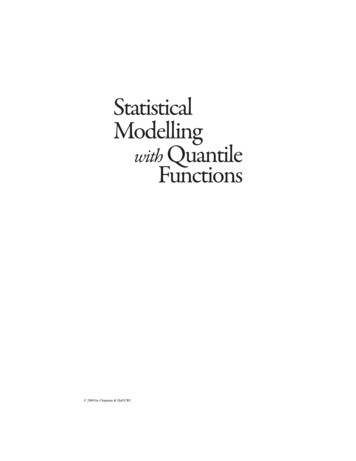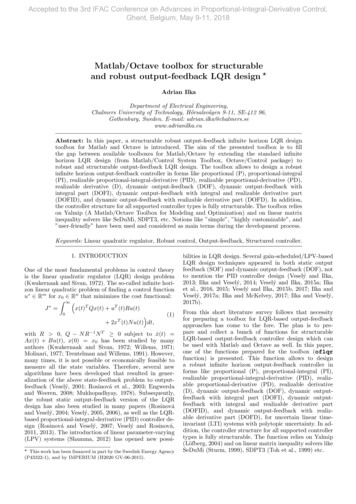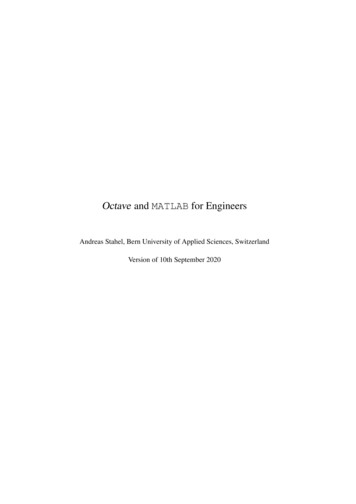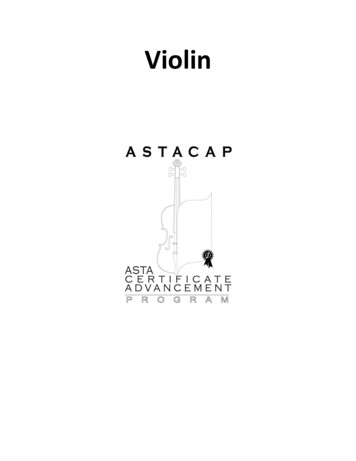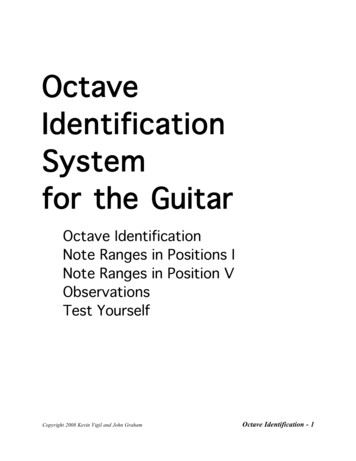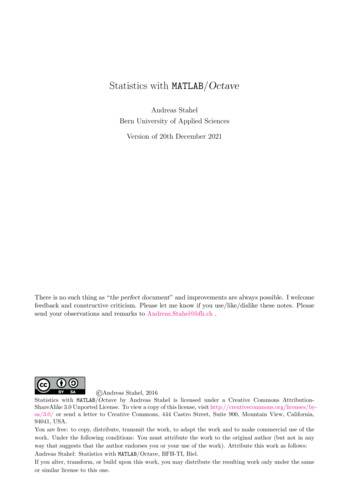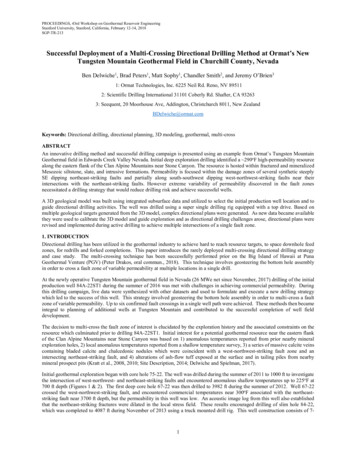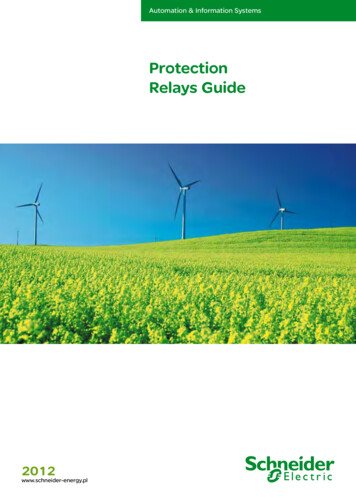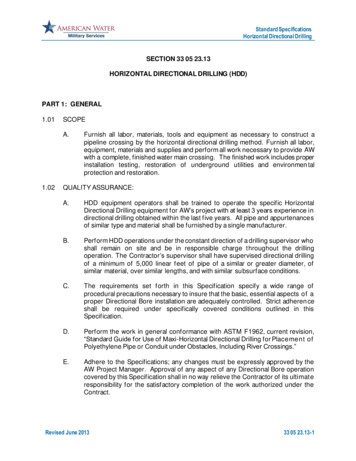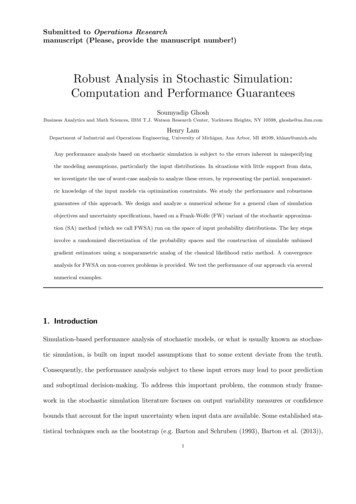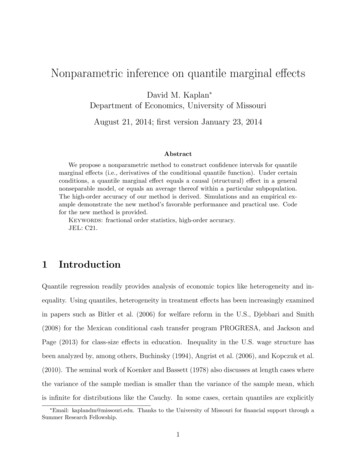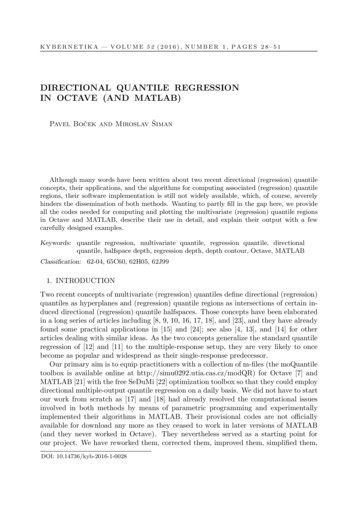
Transcription
KYBERNETIKA — VOLUME 52 (2016), NUMBER 1, PAGES 28–51DIRECTIONAL QUANTILE REGRESSIONIN OCTAVE (AND MATLAB)Pavel Boček and Miroslav ŠimanAlthough many words have been written about two recent directional (regression) quantileconcepts, their applications, and the algorithms for computing associated (regression) quantileregions, their software implementation is still not widely available, which, of course, severelyhinders the dissemination of both methods. Wanting to partly fill in the gap here, we provideall the codes needed for computing and plotting the multivariate (regression) quantile regionsin Octave and MATLAB, describe their use in detail, and explain their output with a fewcarefully designed examples.Keywords: quantile regression, multivariate quantile, regression quantile, directionalquantile, halfspace depth, regression depth, depth contour, Octave, MATLABClassification: 62-04, 65C60, 62H05, 62J991. INTRODUCTIONTwo recent concepts of multivariate (regression) quantiles define directional (regression)quantiles as hyperplanes and (regression) quantile regions as intersections of certain induced directional (regression) quantile halfspaces. Those concepts have been elaboratedin a long series of articles including [8, 9, 10, 16, 17, 18], and [23], and they have alreadyfound some practical applications in [15] and [24]; see also [4, 13], and [14] for otherarticles dealing with similar ideas. As the two concepts generalize the standard quantileregression of [12] and [11] to the multiple-response setup, they are very likely to oncebecome as popular and widespread as their single-response predecessor.Our primary aim is to equip practitioners with a collection of m-files (the moQuantiletoolbox is available online at http://simu0292.utia.cas.cz/modQR) for Octave [7] andMATLAB [21] with the free SeDuMi [22] optimization toolbox so that they could employdirectional multiple-output quantile regression on a daily basis. We did not have to startour work from scratch as [17] and [18] had already resolved the computational issuesinvolved in both methods by means of parametric programming and experimentallyimplemented their algorithms in MATLAB. Their provisional codes are not officiallyavailable for download any more as they ceased to work in later versions of MATLAB(and they never worked in Octave). They nevertheless served as a starting point forour project. We have reworked them, corrected them, improved them, simplified them,DOI: 10.14736/kyb-2016-1-0028
Directional quantile regression in Octave and MATLAB29annotated them, adjusted them to the latest versions of Octave and MATLAB, supplemented them with illustrative demo examples as well as with the tools for processingtheir output, and now we describe them and provide them here with a topical tutorial toanswer the growing demand of our research community. Furthermore, we have alreadytranslated them to R ([19]); see [2].The single-response quantile regression has already become a widespread research tooland as such it has been implemented in common statistical and econometric software bymeans of general or special linear programming algorithms; see [11]. Nevertheless, ourtoolbox has not much in common with all those software solutions as it avoids the singleresponse case (where the parametric optimization using directions as parameters wouldmake little sense) and employs it only internally for initializing the computation. As faras we know, the toolbox has no close software competitors in the general regression casewith multivariate responses except for its R translation mentioned above.Before we focus our attention on the codes, let us briefly review the properties ofboth directional (regression) quantile methods revealed in the aforementioned articles.Although the methods are conceptually different, both are motivated by the standardsingle-output quantile regression.2. THEORYFor the sake of simplicity, we will further consider only the empirical case with n m-dimensional responses Y i associated with p-dimensional regressors X i (1, Z i ) ,i 1, . . . , n m p 1, and with positive weights wi (Y i , Z i ) 0, i 1, . . . , n. Thelocation case (with p 1) thus corresponds to empty vectors Z i , i 1, . . . , n. We will m p 1also assume that the random sample (Y , i 1, . . . , n, comes from ai , Zi ) Rcontinuous distribution. Then all the sample directional quantiles are uniquely definedand the algorithms of [17] and [18] should theoretically work fine with probability onefor all but a finite number of quantile levels τ ’s. All the rare troublesome cases will beignored in our exposition. In the location case with unit weights, they unfortunatelyinclude the popular choice τ i/n, i 0, 1, 2, . . . , n, as well (because these quantilelevels would then lead to infinitely many directional τ -quantiles).Both methods define the directional (regression) quantile hyperplane πτ u (y , z ) Rm p 1 : b τ u y aτ u x 0, x (1, z )and its upper directional (regression) quantile halfspace Hτ u (y , z ) Rm p 1 : b τ u y aτ u x 0, x (1, z )for any direction u Rm \ {0} and for any quantile level τ (0, 1) by means of (thesolution to) the optimization problem (a τ u , bτ u ) argmin(a ,b ) nXwi ρτ (b Y i a X i )i 1subject to a method-specific constraint (b u 1 for Method 1 of [9] and b u forMethod 2 of [16]) where ρτ (x) x τ I(x 0) is the well-known quantile check
30P. BOČEK AND M. ŠIMANfunction andΨτ u nX wi ρτ (b τ u Y i aτ u X i )i 1denotes the optimal value of the objective function computed from the residuals rτ u,i b τ u Y i aτ u X i , i 1, . . . , n. Typically, wi 1, i 1, . . . , n. Nevertheless, integerweights may be useful for handling multiple identical observations, and kernel weightsasymptotically shrinking to zero lead to the local constant multivariate quantile regression of [8] for p 1. The weighted case can be transformed to the unweighted one bysubstitutions Y i : wi Y i and X i : wi X i because the computation does not employany special information about the first coordinate of X i ’s. The transformation changesneither the quantile hyperplane coefficients nor the optimal value of the objective function, which is why we consider only unit weights hereinafter.Next we can consider the finite set Πτ of all directional (regression) τ -quantile hyperplanes passing through exactly m p 1 observations, Πτ πτ u : u Rm , kuk 1, πτ u contains m p 1 observations ,and use it to define at least two meaningful, convex, and polyhedral (regression) τ Aquantile regions, say exact (REτ ) and approximate (Rτ ): REτ πτ u Πτ Hτ u Em p 1: (Y and RAi , Z i ) Rτ }.τ convhull{(Y i , Z i ) RIn other words, REτ is defined as the intersection of all upper directional (regression)τ -quantile halfspaces containing m p 1 observations in the bordering directional(regression) quantile hyperplanes, and RAτ is the convex hull of all the observationsAEbelonging to REτ . The borders of Rτ and Rτ are sometimes called (exact) and approxAimate τ -quantile contours, respectively. The sets Πτ , REτ , and Rτ do not depend onthe directional quantile method used. If REisdifficulttoobtaindueto the very largeτcanbeusedasitsapproximationbecausewecan know thecardinality of Πτ , then RAτobservations in ts. It isτalso good to know that REmustbenon-empty(andthuscontainatleastone point ofτRm p 1 ) for any τ 1/(m p). The z 0 -cuts of these regions for various z 0 Rp 1 ,m EREτ (z 0 ) {y R : (y , z 0 ) Rτ }m Aand RAτ (z 0 ) {y R : (y , z 0 ) Rτ },prove especially useful for detecting heteroscedasticity in a general regression case.In the location case with originally unit weights, Πτ consists of all those hyperplanespassing through exactly m observations that cut off at most bnτ c and at least dnτ e mpoints from the data cloud. Consequently, the exact regions REτ must then coincidewith the corresponding halfspace depth regions and thus have all their properties, see,e. g., [3, 6], and [20]. Their sure convexity makes them substantially different fromdensity contours in the case of multimodal distributions that may easily arise evenfrom very simple mixtures, see, e. g., [5]. We can also conclude that Πτ then alwayscontains enough material for computing m neighbouring exact contours simultaneouslyAif (m 1)/n τ 0.5. This may simplify or speed up the computation of REτ and Rτfor p 1.
Directional quantile regression in Octave and MATLAB31How do the methods differ? Mainly in the optimization constraint and its consequences. Method 1, introduced to the large statistical community in [9], uses theconstraint b u 1 that leads to the scalar Lagrange multiplier λτ u equal to Ψτ u . Onthe other hand, Method 2 of [16] employs the constraint b u, which results in theLagrange multiplier vector µbτ u linked to Ψτ u through the formula Ψτ u µb τ u u. But itis still more or less the ordinary τ -quantile regression of all projections u Y i ’s on X i ’s.The optimization problems involved in the two methods can be solved for all nonzerou’s in Rm by means of parametric linear programming. It turns out that the spaceRm \ {0} of all directions can be segmented into blunt polyhedral cones where theobservations with zero residuals do not change and the solution has a simple form. Ineach cone, this technique also produces the Lagrange multipliers (or, dual variables)associated with residuals. The dual variables corresponding to positive and negativeresiduals are boring as they always equal τ and 1 τ , respectively. On the otherhand, the Lagrange multiplier vector µrτ 0u associated with zero residuals must have allits data-dependent coordinates in ( τ, 1 τ ). They might be used not only like therank scores in the standard quantile regression, but also for defining halfspace depth ofindividual observations as in (5.1) of [16].As for Method 1, there must exist a finite conic segmentation Γ(τ ) {Cq (τ ) : q 1, . . . Nτ } of Rm such that each Cq (τ ) is a non-degenerate closed convex polyhedralcone, and bτ u bq,τ /dq,τ (u), aτ u aq,τ /dq,τ (u), λτ u λq,τ /dq,τ (u), (Ψτ u λτ u ), and µrτ 0u Vq,τ u/dq,τ (u) for any 0 6 u Cq (τ ) where dq,τ (u) b q,τ u andbq,τ Rm , aq,τ Rp , λq,τ R, and Vq,τ R(m p 1) m are constant objects up totheir possible dependence on τ and q. In other words, all directions u inside Cq (τ ) leadto the same hyperplane coming through m p 1 observations, up to the multiplicativefactor used for scaling its coefficients.As for Method 2, there must exist a finite conic segmentation Γ(τ ) {Cq (τ ) : q 1, . . . , Nτ } of Rm such that each Cq (τ ) is a non-degenerate closed convex polyhedralr0r0cone and bτ u u, aτ u Aq,τ u, µbτ u µbq,τ , (Ψτ u µb q,τ u), and µτ u µq,τ for any0u Cq (τ ) where Aq,τ Rp m , µbq,τ Rm , and µrq,τ Rp are u-independent entities ineach Cq (τ ) though they may vary with τ and q. In other words, each interior direction uof Cq (τ ) corresponds to a different hyperplane passing through the same p observations.Each τ -quantile hyperplane passing through m p 1 observations must thus correspondto a vertex direction of some Cq (τ ). Such directions may also correspond to τ -quantilehyperplanes having some of their coefficients zero and passing through less than m p 1observations. Two adjacent cones of Γ(τ ) need not always differ in the p observationsfitted by the hyperplanes associated with their interior directions, but sometimes onlyin the sign of one of the quantile hyperplane regression coefficients.The segmentations Γ(τ )’s can be used for exact and efficient computation of many useful statistics defined by means of projection pursuit such as projection depth, skewness,kurtosis, and many other statistics based on the directional multipliers and quantilehyperplane coefficients presented here; see [23]. As Γ(τ ) Γ(1 τ ) and πτ ( u) π(1 τ )(u) , we allow only τ [0, 0.5] hereinafter.Before proceeding further, we should finally clarify our illuminating notation. Thatis to say that we consistently use the same symbols for analogous but different entitiesfiguring in both methods (bτ u , aτ u , Ψτ u , µrτ 0u , Γ(τ ), Nτ , etc.). It should be always clear
32P. BOČEK AND M. ŠIMANwhich method they belong to unless it is irrelevant to the statement made about them.In any case, we would like to point out that both the conic segmentation Γ(τ ) and thenumber of its conic segments Nτ also depend on the method employed.Our toolbox primarily contains method-specific functions for computing all the important information about all the cones in Γ(τ ) that then makes it possible to calculatethe optimal solution for any given u. These functions are complemented with someauxiliary codes, instructional examples, and also with the function for computing theτ -quantile contours. Let us have a close look at it.3. IMPLEMENTATION3.1. Description of the toolboxThe toolbox consists of one m-file for computing the (regression) quantile contours (evalContour.m); two method-specific m-files for solving the parametric programming problems involved in Methods 1 and 2 (compContourM1u.m and compContourM2u.m), with:– two method-specific auxiliary m-files for generating their default input structure CTechST driving the computation (getCTechSTM1u.m and getCTechSTM2u.m),– two method-specific m-files generating the output in the structure CharST(getCharSTM1u.m and getCharSTM2u.m),– two method-specific auxiliary m-files for finding their initial solutions (findOptimalBasisM1FromScratch.m and findOptimalBasisM2FromScratch.m),– two auxiliary m-files for testing their input for correctness (checkArray.m andcheckCTechSTu.m),– five auxiliary m-files for manipulating internal auxiliary lists (addItem.m,addRow.m, delItem.m, findItem.m, and findRow.m); five m-files with instructional examples (ExampleA.m, ExampleB.m, ExampleC.m,ExampleD.m, and ExampleE.m).Generally, the method related to a method-specific m-file is indicated with M1 or M2 inits filename, and Mi is used for both M1 and M2. The auxiliary files are not supposedto be modified by the user.All the codes should work both in Octave and MATLAB. Nevertheless, their outcomescan vary because of the different initialization of the random number generators there,which may affect the simulated input data (as in ExampleA.m to ExampleE.m) or thestarting cone(s), for example. The same input should nevertheless lead to the same setsof distinct quantile hyperplanes. The examples ExampleA.m to ExampleE.m have beentailored to Octave and thus it is their Octave output that is discussed further below.All the main codes are richly annotated and should be comprehensible with the aidof [17] and [18]. We strongly suggest the reader to study both of the technical articles
Directional quantile regression in Octave and MATLAB33before reading further and trying to understand the codes because the files compContourM1u.m and compContourM2u.m respectively follow the algorithms described thereto the last detail. The function evalContour.m mainly contains the vertex enumerationfor identifying contour vertices, also mentioned in the two articles.All method-specific codes can be studied side by side because they have been intentionally written in a way highlighting their similarities.Although we cannot repeat here all the technical details, we can comment on thetheoretical computational complexity of the algorithms behind Method 1 and Method 2for fixed m and p. The computational complexity, say Ci , of finding the initial solutioncan be theoretically made as low as O(n) almost surely under some regularity conditionsaccording to Theorem 6.4 in [11]. The computational complexity of finding all the othersolutions from the first one can then be made as low as O(nNτ ) in case of Method 1,and also in case of Method 2 if m 2 or if m 2 and only relatively few cones havemore than O(1) vertices; see [1] for the optimal complexity of the convex hull algorithminvolved. Recall that Nτ denotes the number of cones in the conic segmentation Γ(τ )that is closely linked to the number of all distinct τ -quantile hyperplanes.Nevertheless, our implementation of the toolbox is not optimal. For example, ituses inefficient SeDuMi solver for finding the initial solution because it is very reliable,accurate, and already available for both Octave and MATLAB. It negatively affectsespecially the computation of bivariate or extreme contours. The same reasons leadus to employ the convex hull algorithm whose theoretical computational complexity isunknown; see [1].For the sake of clarity, we will further state predefined values in parentheses just afterthe variable or field name.3.2. Solving the parametric programming problemsThe parametric program involved in the ith-method can be solved by compContourMiu.m with the following header:COutST compContourMiu(Tau, YMat, XMat, CTechST), i 1, 2.3.2.1. InputNaturally, Tau corresponds to τ and YMat Rn m (resp. XMat Rn p ) is a matrix containing Y j (resp. X j ) in its jth row, j 1, . . . , n. All these three parameters arenumeric arrays. As far as the problem size is concerned, the program expects τ [0, 0.5],n m p 1, and 2 m 6, and it should work reliably for problems characterized bythe triples (m, n, p) up to (2, 10000, 10), (3, 500, 5), and (4, 150, 3) where smaller valuesof n and p are also permitted. In general, the computation becomes prone to numericalerrors and too time/memory consuming with increasing m, n, p, and τ .The last input argument is a structure whose default value is generated by theauxiliary function getCTechSTMiu without any input. If some input argument tocompContourMiu is provided, then all the preceding ones must be assigned as well.If the last input argument is missing, then the default structure is used. If the thirdargument is missing as well, then XMat is assumed to be the column unit vector of theright length.
34P. BOČEK AND M. ŠIMANThere is no need to enter the last argument in most cases because the default settingshould usually work well. But let us describe it in detail anyway. The structure CTechSTcontains some parameters controlling the computation. Its fields say the following:ReportI (0): if some auxiliary information is reported on the screen to make the progess of the computation visible. Of course, it takes some execution time, especiallyfor m 2. What is then displayed? The value of τ (Tau) (but only if it was internally changed from a problematic input value leading to integer nτ ), the initialL2 -normed directional vector u0 used (U0Vec), the number of failures to find anaccurate initial solution by the SeDuMi solver (NNotFound), the number of foundaccurate initial solutions with an inconvenient number of virtually zero coordinates(NBad), and also the width of each layer of the breadth-first search algorithm if itis employed.OutSaveI (0): if the output is saved in file(s) on the disk. If not, then the output islost except for the results stored in COutST, which is especially useful for largeproblems or simulations.D2SpecI (1): if all the cones are passed through counter-clockwise when m 2. Otherwise, the computation runs in the same way as for m 2. The default settingshould be preferred in most cases as it avoids some possible sources of errors.BriefOutputI (1): if brief or verbose output information is computed. It always includes ConeID (the identification number of the cone), Nu (the number of negativeresiduals corresponding to all the directions in the interior of the cone), and UVec(the nonzero vertex or other vector u of the cone that is L2 -normalized if bothm 2 and CTechST.D2SpecI 1, and L -normalized otherwise). In general, theoutput rows depend both on the method and on the value of BriefOutputI:Method 1:1: [ConeID, Nu, UVec , BDVec , ADVec , LambdaD] R , 1 1 m m p 1,0: [ConeID, Nu, UVec , BDVec , ADVec , LambdaD, vec(VUMat) , IZ ] R , 1 1 m m p 1 (m p 1)m (m p 1),where BDVec, ADVec, LambdaD, and VUMat respectively stand for bq,τ , aq,τ ,λq,τ , and Vq,τ from Section 2, for the q corresponding to ConeID.Method 2:1: [ConeID, Nu, UVec , vec(ACOMat) , MuBRow] R , 1 1 m pm m,0: [ConeID, Nu, UVec , vec(ACOMat) , MuBRow, MuR0Row, IZ ] R , 1 1 m pm m p p,where ACOMat, MuBRow, and MuR0Row respectively stand for Aq,τ , µb q,τ , and0 µrq,τfrom Section 2, for the q corresponding to ConeID.As for vector IZ (or I Z in the technical articles), it contains indices of the originalobservations with zero residuals. Its coordinates match those of MuR0Row andthus link the multipliers (or zero residuals) with concrete data points.
Directional quantile regression in Octave and MATLAB35Even the output for BriefOutputI 1 provides the information sufficient forcomputing the contours as well as bτ u , aτ u , Ψτ u , and λτ u (Method 1) or µbτ u(Method 2). If one also wants to know µrτ 0u or all the observations on πτ u insideeach cone, then he or she should set BriefOutputI 0 and OutSaveI 1 before thecomputation in order to obtain the output file(s) with the required information.Finally, we should probably point out a few not-so-obvious facts.Firstly, both the codes work with the objective function presented here that isn-times higher than the sample version of the population objective function in thedefinition of directional quantiles of [9] and [16]. Consequently, all the multipliersproduced by the codes are n-times higher than those resulting from the originaldefinition.Secondly, the set of all output vectors u’s generally consists not only of all thecone vertices, but also of some additional directions pointing to the vertices of theintersections of the cones with the artificial bounding box [ 1, 1]m (and possiblywith the orthants). Such redundant vertices only contaminate the output and theiruseless rows should be deleted from it before its further analysis.Thirdly, the same cone may theoretically appear in the output more than onceunder different ConeID identifiers, unless m 2 and CTechST.D2SpecI 1.CubRegWiseI (1): if the directional space is divided into orthants investigated separately, which splits the problem to 2m smaller ones. This is helpful for solvinglarge problems with m 2 although it also generates some artificial cones with afacet in the orthant borders and may slow down the computation in some cases.ArchAllFI (1): if the internal archive should contain all the past cone facet identifiersor only those from the last few layers. The latter way may be faster and lessmemory demanding but the former choice makes the computation more likely toterminate successfully. This is why storing all facet identifiers is highly recommended and even enforced by the program for m 3.(only for Method 2) SkipRedI (0): if the information from some cones is ignored,namely from the cones whose all facets are already known except for those artificially induced. This skipping saves some time and space, and it still almostsurely preserves all vertices and information relevant to the contour computation.Therefore, it might be useful for solving very large problems. On the other hand,it makes the information in COutST regarding the inner points unreliable.OutFilePrefS (’DQOutputMi ’): what is the prefix of possible output file names.Their suffix is always .dqo. And in between, there is the number of the file paddedwith zeros to form 6 digits. The default name of the first output file resulting fromMethod 1 is thus DQOutputM1 000001.dqo.SeDuMiPathS (”): the path to the SeDuMi directory. It is employed only whenSeDuMi cannot be found by the software.
36P. BOČEK AND M. ŠIMANThe fields CubRegWiseI, ArchAllFI, and possibly SkipRedI are relevant only if thebreadth-first search algorithm is used. They should be changed only when the defaultsetting of CTechST fails, i. e., in case of very large problems beyond dimension two.See directly getCTechSTMiu.m for further details.3.2.2. Fixed outputIt still remains to describe the output structure COutST. Its fields contain useful summary statistics regarding the computation:CharST: a user-defined output structure.CTechSTMsgS (”): ” or a self-explaining warning message regarding CTechST.ProbSizeMsgS (”): ” or a self-explaining warning message regarding the problem size.CompErrMsgS (”): ” or a self-explaining error message regarding the computation.TauMsgS (”): ” or a self-explaining warning message regarding the τ .PosVec (0n ): the vector of length n indicating the positions of individual observationswith respect to the (exact) τ -quantile region. PosVec(j) 0/1/2 if the jth observation lies in the interior/border/exterior of that region, j 1, . . . , n. This information is reliable only after a successfully finished computation. If CTechST.SkipRedI 1, then PosVec correctly identifies only all the outer observations.NDQFiles (0): the number of output files.NumB (0): the number of (not necessarily different) optimal bases considered.MaxLWidth (0): the maximum width of one layer.NIniNone (0): the number of SeDuMi failures to find an accurate initial solution.NIniBad (0): the number of found accurate initial solutions with an inconvenient number of virtually zero coordinates.NSkipCone (0): the number of skipped (almost degenerate) cones whose facet verticescould not be evaluated because no interior points sufficiently inside the cones(needed for the vertex enumeration by means of convhulln) could be found.If CTechST.CubRegWiseI 1, then the last four fields are calculated over all the individual orthants.Furthermore, if CTechST.OutSaveI 1, then the output files (with rows determinedby CTechST.BriefOutputI described above) are always saved to the working directory.
Directional quantile regression in Octave and MATLAB373.2.3. User-defined outputThe structure CharST is computed inside compContourMiu by means of getCharSTMiuwith the following header:CharST getCharSTMiu(Tau, N, M, P, BriefDQMat, CharST, IsFirst).Naturally, Tau, N, M, and P stand for τ , n, m, and p, respectively. The function is firstcalled with BriefDQMat [], CharST [], and IsFirst 1 to initialize CharST, andthen repeatedly with IsFirst 0 for each (potential) output file content in BriefDQMatto update CharST. (That is to say that BriefDQMat then successively contains therows of potential individual output file(s) corresponding to CTechST.BriefOutputI 1). This function thus makes it possible to obtain all required information during therun of compContourMiu without storing anything on the disk, i. e., without using theexternal output files at all (which might otherwise occupy even many gigabytes of thehard disk space in case of large multi-dimensional problems).We provide a non-trivial suggestion for getCharSTMiu as a guidance for the usersto create their own modifications. By default, the output structure CharST has thefollowing fields:NUESkip (0): the number of (skipped) hyperplanes corresponding to the directionsartificially induced by the [ 1, 1]m bounding box.NAZSkip (0): the number of (skipped) hyperplanes (not counted in NUESkip) withat least one coordinate of aτ u zero.NBZSkip (0): the number of (skipped) hyperplanes (not counted in NUESkip) withat least one coordinate of bτ u zero.(if m 4) HypMat ([]): the matrix with (m p) columns where only the distinct hyperplane coefficients (b τ u , aτ u ) not contributing to NUESkip, NAZSkip, andNBZSkip are stored in rows after being normalized with kbτ u k for Method 1,rounded, and sorted lexicographically.CharMaxMat (all elements -Inf ): the matrix with maxima of certain directionalstatistics over all the hyperplanes in HypMat (before the normalization of theircoefficients) and corresponding cone vertices. Each row contains one such maximum in the last coordinate and one of the directions where it is attained in thepreceding ones.CharMinMat (all elements Inf ): the matrix containing minima of certain directional statistics over all the hyperplanes in HypMat (before the normalizationof their coefficients) and corresponding cone vertices. Each row contains one suchminimum in the last coordinate and one of the directions where it is attained inthe preceding ones.
38P. BOČEK AND M. ŠIMANConcerning Method 1:CharMaxMat u max kbτ u k u max Ψτ u umax(Ψτ u /kbτ u k) (2)(p) u maxk(aτ u , . . . , aτ u ) k (p) u max k(a(2),.,a)k/kbkτuτuτu (2) u max aτ u (2) u max a /kbkτuτu ······ (p) umax aτ u (p)u max aτ u /kbτ u kCharMinMat u u u u u min kbτ u kmin Ψτ umin (Ψτ u /kbτ u k)(p) (2) min k(aτ u , . . . , aτ u ) k (2)(p) min k(aτ u , . . . , aτ u ) k/kbτ u kand Method 2: u u u u ···u CharMaxMat max Ψτ umax kµbτ u k(2)(p)max k(aτ u , . . . , aτ u ) k(2)max aτ u ···(p)max aτ u CharMinMat u u u min Ψτ u min kµbτ u k(2)(p) min k(aτ u , . . . , aτ u ) kwhere u in each matrix row stands for one of the directions where the correspondingmaximum or minimum is attained. The last rows are included only if p 2. Ordinaryusers interested solely in the quantile contours will need only HypMat. They neednot change the default functions if they do not intend to experiment with five- or sixdimensional responses.3.3. Computing the contoursIf AAMat is a matrix with two to six columns and BBVec is a vector with the same number of rows, then the set of inequalities AAMat*z BBVec defines a convex polyhedralregion whose approximate volume, vertices, and facets can be computed byCST evalContour(AAMat, BBVec) or CST evalContour(AAMat, BBVec, IPVec)where IPVec is a point known to be well in the interior of the region. It is alwaysbeneficial to enter a known point IPVec as the last argument, especially in ter
IN OCTAVE (AND MATLAB) Pavel Bo cek and Miroslav Siman Although many words have been written about two recent directional (regression) quantile concepts, their applications, and the algorithms for computing associated (regression) quantile regions, their software implementation is still not widely available, which, of course, severely
